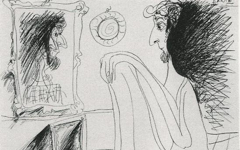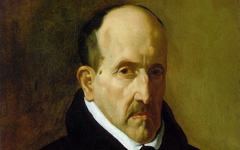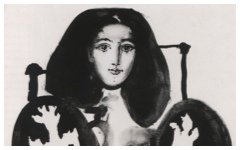Picasso’s Female Nude in Profile (1902)

Picasso, Female Nude in Profile (Hommage à Gauguin) (1902) Inscribed "Paul Picasso" in 1903. Conté crayon and charcoal on paper.
Click image to enlarge.
Early in his career, and shortly after arriving in Paris, Picasso absorbed the work of various masters so thoroughly that he took on their identity as well. In this drawing a nude woman, resembling one of Gauguin's Tahitian goddesses, walks gracefully to the right, her hand extended. Whatever it touches is not clearly described leaving the emphasis on touch entirely in the hand. A hand touching, especially one like this, the focus of the whole composition, usually symbolizes the act of "painting." Also, the girl's long black hair is in such contrast to the rest of the paper that it, too, seems to suggest the hairs of a paintbrush, as does its shape. Picasso puns on the different media by making the charcoal resemble one thick, slightly meandering brushstroke across the page.
Click next thumbnail to continue
The girl's identity as a feminine personification of the artist is confirmed by the artist's bold inscription near her feet. Picasso is thought to have added it a few months' later after Paul Gauguin's death in May, 1903.1 "Paul Picasso", he wrote, identifying with the dead artist's spirit, a link made even stronger by the coincidence of their names. Pablo, in English and French, is Paul.
Click next thumbnail to continue
Death as the symbol for an artwork's completion has a long tradition in Western art, well known among artists. By adding the date of Gauguin's death, rather than the actual date of the composition, Picasso's strengthens his own identification with Gauguin, the girl's personification of both artists and the drawing itself as a finished work of art.
Notes:
1. Susan Grace Galassi in Picasso's Drawings, 1890-1921 (New York: Frick Collection) 1911, p.97
Original Publication Date on EPPH: 02 Nov 2011. | Updated: 0. © Simon Abrahams. Articles on this site are the copyright of Simon Abrahams. To use copyrighted material in print or other media for purposes beyond 'fair use', you must obtain permission from the copyright owner. Websites may link to this page without permission (please do) but may not reproduce the material on their own site without crediting Simon Abrahams and EPPH.





